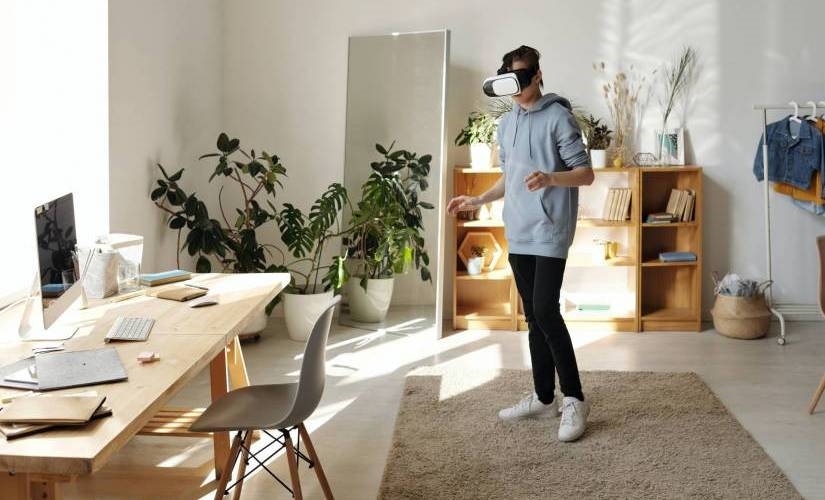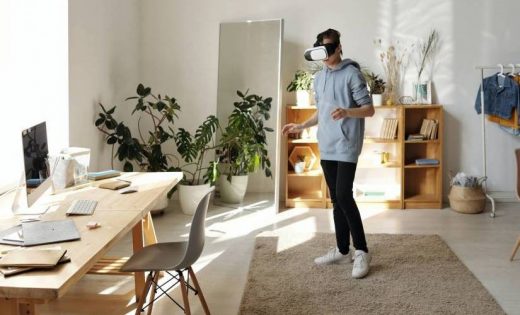How Virtual Reality is Transforming the Future of Work
How Virtual Reality is Transforming the Future of Work

In 2019, more than 4.3 million people in the U.S. worked remotely. During 2020 that number increased significantly due to COVID-19. Most companies, because of the quarantine, had to implement working from home policies. But taking the pandemic aside, remote work was already growing at full speed. Recent studies show that many benefits come along when people have the flexibility to work from their homes or in the place they enjoy most. Here is how virtual reality is transforming the future of work.
Although there are many proud defenders of the remote work movement and all the wonders it has, there is still one main issue most virtual teams face. Remote companies, and overall distributed teams, often feel that the levels of connection are not the same as in an on-site office.
We are not in the 1900s where there was no internet, and traveling through an airplane was still a fantasy. Remote teams have the necessary tools to strengthen their company’s culture and collaboration levels. And as time passes by, these tools are upgrading to a whole new level. And we haven’t even mentioned the effects of COVID this year or what may happen this next year.
Technology is taking one step further to power and transform the future of work with Virtual Reality (VR). The way distributed teams connect and collaborate is changing forever.
An Overview of the Virtual Reality Industry
Many companies are making considerable investments in virtual reality (VR) and artificial intelligence (AI). They say it’s the future of everything. Even though VR developments started in the early 90s, its market has received significant growth in the past years. The market size of consumer virtual reality hardware and software increased from 6.2 billion dollars during 2019, and it’s expected to be valued at more than 16 billion dollars by 2020.
The gaming and the entertainment industry are the ones who, at the moment, are taking more advantage of this technology. Companies like Samsung, Google, and PlayStation sell goggles, gloves, and other tools for consumers to purchase and take video gaming to a whole new level.
However, VR is increasing in the educational industry also. For instance, medical schools are starting to implement this type of technology to train surgeons. Artificial Intelligence is also used to help scientists understand complex problems and investigate deeper aspects.
Virtual Reality and Remote Work
Is the future of work part of the VR panorama?
Most of us who run remote companies and sometimes have a blast during meetings wish deeply to soon reunite in person with the whole company to share drinks! I love working remotely, but it’s a fact that the human connection is not the same in a digital environment. Yes, there are many communication tools, but the fundamentals of communication are different from in-person interaction. This is when the magic of virtual reality helps to deal with these kinds of challenges.
Think about it this way; most of the downsides and disadvantages of working remotely are related to how teams interact and connect. For example, several studies prove that many remote employees have felt isolated and even left out of the company. Other teams have had bad experiences working remotely because they felt their collaboration levels were not the same.
Virtual Reality offers such an immersive experience when managing a remote workforce. You and your team will feel you are in the same office space! But instead of commuting, drinking horrible coffee, and having to wake up earlier, you’ll be working from the comfort of your house. You’ll feel you are physically there with your team in the same meeting room while brainstorming ideas or solving a problem. Most of the “cons” you see in many anti-remote work articles will disappear once teams start applying VR as their primary remote work tool.
Here are some of the many applications VR will offer to companies:
1. Better interviews with remote candidates
Most of us have experienced how remote interviews are. In the first place, for those who are not accustomed to cameras, it might be even an uncomfortable experience. And for employers, virtual interviews are harder than regular ones because you miss out on important aspects such as body language. With VR interviews, you’ll feel you are doing a regular interview because there will be no camera barrier, just you and the candidate.
2. Better talent
Throughout these years managing a remote company and recruiting top tech talent to other companies, we’ve realized how much people want to have the opportunity to work from their homes. It’s one of the best strategies to recruit the best talent worldwide.
People are not longer seeking fancy offices with creative spaces. People want the flexibility of having a job that allows them to enjoy the things they love the most. Imagine adding remote work, plus virtual reality, to your showcase. You’ll attract even more talented employees who want to connect with their co-workers while working remotely.
3. Strengthen your company’s culture
This is probably one of the most significant benefits of implementing VR in your company. Culture means connection. When your employees enjoy working with each other, distance barriers are broken. However, it’s not the same (and it will never be) laughing on a video call than feeling you are physically there hanging out with them. With VR, you’ll be able to organize birthday parties, happy hours, gaming nights, and other fun activities to make stronger bonds.
4. Better onboarding
Onboarding is a crucial step in your company. If you don’t share your passion with new employees or explain to them carefully how the company works, with your vision, mission, and more about your company’s culture, they won’t feel attached. With no explanation, a team member won’t understand why their work will be valuable in the company.
Unattached employees are likely to leave the job faster because they don’t feel connected or passionate about what they are doing or the company they are working for.
With VR, the onboarding process is much easier. You can even walk them through a virtual office experience while explaining to them how everything works. You can introduce them to the team, and they will feel as if they were in the actual office building, meeting everyone.
5. Change the way you test technical abilities
Some job positions require specific technical skills that candidates must have. Testing tech talent, specifically technical skills, and doing it remotely is a challenge.
Although there are online platforms or even video calls where testing candidates is a possibility, VR takes video calls to a whole new level. For example, if you need a dev on your team — with VR, you’ll be able to see how your candidate solves a specific technical problem. Using only regular video calls — you cannot see well — and could miss some vital information.
Are you ready for the VR Reality Scenario?
We still have a long way to go until VR is as common as having a phone. Many companies are selling their VR products to a more narrow audience. Prestigious academic institutions are starting to see VR as a tool to help them achieve better research. Even the army has started using this to simulate battlefield situations.
Taking an audience and expanding its focus and view to the whole world’s workforce isn’t easy. It requires a lot of investment, and not all companies are in the position of spending millions of dollars to make the magic happen.
Still, with remote work taking over 2020 and technology improving as time passes, this could be the last year where people drive 2 hours to get to an office. When VR becomes common at companies, there will be no need to spend money renting fancy buildings and other significant expenses because everyone will work from their homes. Or a great amount of work will take place anywhere in the world that has reliable wifi.
Remote work is ready to embrace virtual reality. What about you?
The post How Virtual Reality is Transforming the Future of Work appeared first on ReadWrite.
(47)


